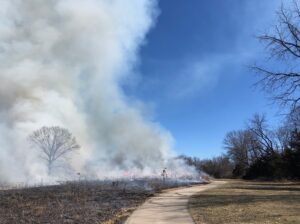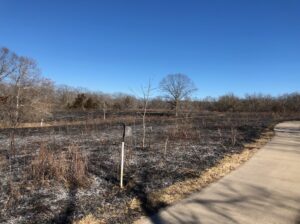First Prescribed Fire at Bonnie View NS Grassland Restoration Project
by Bill Mees, Nature Areas Committee
Time really does seem to fly. After two years of preparation work Columbia Audubon Society seeded 15 acres with native Missouri grasses and forbs on January 21, 2016. This process converted what was a fescue dominated pasture to a facsimile of a prairie. The summer of 2022 was the seventh growing season for the prairie which by now was experiencing the encroachment of woody species and a significant accumulation of thatch. It was time for a fire, so on February 11, a beautiful Saturday, a match was lit.
Fire has been a part of prairie ecosystems for as long as prairies have existed; they evolved together. Prairies love fire. Burning the dead vegetation releases nutrients back into the soil, and allows sunlight to warm the bare soil more quickly. Both stimulate native plant growth in spring
Prairies receive other benefits from fire. Fire can control woody vegetation. Without fire prairies would become overgrown with trees and shrubs. It also helps manage some non-native herbaceous plants that can invade prairies.
A question: The fire at Bonnie View NS only burned 6 acres of the 15-acre prairie. Why not burn it all? Good question!
There are several reasons why the entire 15-acre tract of prairie was not burned. Every fire has both positive and negative consequences. Some wildlife needs more open (post burn) native vegetation during growing season, others need the previous growing season’s denser vegetation in spring and summer. Also, there are many native bee larvae developing in the stems of dead standing vegetation as well as caterpillars and other insect larvae that overwinter in the accumulated thatch. These will succumb to the fire. The bees and larvae in the adjoining unburned acres will repopulate the burned acres.
All this is to say, the fire was needed to maintain a healthy prairie. While only 6 acres was burned this year, stand by. Next fall/winter another portion of the prairie will receive, via fire, a much needed “hair cut”.
Columbia Audubon Society wishes to thank our partners in Columbia’s Parks and Recreation Department for making this first burn possible.


